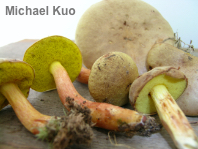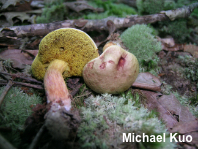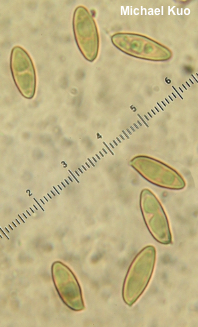| Major Groups > Boletes > Aureoboletus viridiflavus |

|
Aureoboletus viridiflavus [ Basidiomycota > Boletales > Boletaceae > Aureoboletus . . . ] by Michael Kuo This subtly beautiful bolete features a bright yellow, nonbruising pore surface, a streaky reddish stem, and an olive shaded, dry cap that features reddish spots and discolorations. The basal mycelium is white, and, under the microscope, the spores measure 12–15 µm long. Aureoboletus viridiflavus was originally described by Coker & Beers (1943) from North Carolina. They described the cap color as "a peculiar olivaceous gold with reddish areas." In other respects the species is a dead ringer for Aureoboletus auriporus. However, Coker & Beers used the name "Boletus auriporus" for the mushroom most authors now treat as Boletus innixus—so the question of whether or not Boletus viridiflavus is merely their name for Boletus auriporus arises. Singer (1947) and Both (1998) believed this was the case. Snell & Dick (1970) described the colors of "Pulveroboletus auriporus" to account for olive tones. Weber & Smith (1985) appear to illustrate what I am calling Aureoboletus auriporus as "Boletus viridiflavus." I have made several collections that appear to match the cap colors described by Coker & Beers for Boletus viridiflavus. While other features (including microscopic features and chemical reactions) are virtually identical, the olive cap looks strikingly different in the field from typical Aureoboletus auriporus specimens. Citing a previous version of this webpage as an illustration of the species, Klofac (2010) transferred Boletus viridiflavus to Aureoboletus on the basis of its morphology. Boletus viridiflavus is a former name. Description: Ecology: Mycorrhizal with oaks and possibly other hardwoods; growing scattered, or gregariously; summer; distribution uncertain. The illustrated and described collection is from Illinois. Cap: 2.5–6 cm; convex, becoming broadly convex; dry; when young very finely velvety, becoming nearly bald with age; olive yellow to olive brown, with reddish spots and discolorations, fading to olive tan; the margin with a tiny overhanging, sterile portion. Pore Surface: Bright yellow, becoming olive yellow with age; not bruising; 1–2 angular pores per mm at maturity; tubes to 10 mm deep. Stem: 3–4 cm long; 8–11 mm thick; more or less equal; bald; sometimes a little sticky when fresh; yellow near apex; elsewhere streaked with reddish and reddish brown; not reticulate; basal mycelium white. Flesh: Pale yellowish; not changing on exposure. Odor and Taste: Not distinctive. Chemical Reactions: Ammonia slowly pinkish on cap; negative on flesh. KOH orangish on cap; orangish on flesh. Iron salts negative on cap; negative to pinkish on flesh. Spore Print: Not recorded (probably olive). Microscopic Features: Spores 12–15 x 4.5–5.5 µm; fusiform; smooth; yellowish in KOH. Hymenial cystidia 35–50 x 5–7.5 µm; lageniform; smooth; thin-walled; hyaline in KOH; infrequent. Pileipellis a cutis; elements 5–7.5 µm wide, smooth, hyaline in KOH; exserted ends cylindric with rounded apices. REFERENCES: (Coker & Beers, ex. W. Klofac, 2010. (Coker & Beers, 1943; Weber & Smith, 1985; Metzler & Metzler, 1992; Klofac, 2010; Zhang et al., 2019.) Herb. Kuo 07110701. This site contains no information about the edibility or toxicity of mushrooms. |
© MushroomExpert.Com |
|
Cite this page as: Kuo, M. (2020, January). Aureoboletus viridiflavus. Retrieved from the MushroomExpert.Com Web site: http://www.mushroomexpert.com/aureoboletus_viridiflavus.html |


